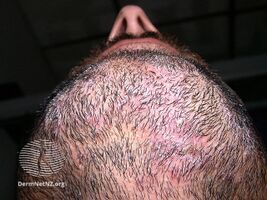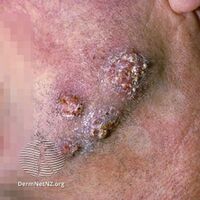Tinea barbae
| Tinea barbae | |
|---|---|
| Other names: Barber's itch, Tinea sycosis, ringworm of the beard,[1] | |
 | |
| Tinea barbae or "barber's itch" | |
| Specialty | Infectious disease |
| Symptoms | Beard area: Redness, lumps and small bumps, scale, dull fragile hair[2] |
| Types | Deep, superficial[2] |
| Causes | Trichophyton violaceum, Trichophyton rubrum, Trichophyton mentagrophytes, T. verrucosum[2] |
| Diagnostic method | Microscopy of plucked hair[3] |
| Differential diagnosis | Bacterial folliculitis, furuncle, perioral dermatitis, contact dermatitis, herpes simplex, pseudofolliculitis barbae[3] |
| Treatment | Antifungals[3] |
| Medication | Terbinafine, itraconazole, griseofulvin, fluconazole[3] |
| Frequency | Uncommon[3] |
Tinea barbae is a type of fungal infection of the skin and hair that affects the moustache and beard area.[2] It typically presents as red patches with scale, associated with dull fragile hair.[4] The infection occurs as a superficial folliculitis with small bumps or a deep type (tinea barber profounda) with larger bumps.[1][3]
The superficial type is generally caused by Trichophyton violaceum and Trichophyton rubrum, and the deep type by Trichophyton mentagrophytes and T. verrucosum.[2] Farm workers are most at risk.[3]
It is most common among agricultural workers, as the transmission is more common from animal-to-human than human-to-human.[4] The condition was first described by David Gruby in 1842.[4]
Signs and symptoms
There are typically red patches with small bumps and crusting around the hairs of the beard and moustache area.[5] The hairs are easily pulled out.[5] It may be itchy or painful to touch.[5]
-
Tinea barbae (superficial)
-
Tinea barbae (deep)
-
Tinea barbae [6]
Causes
The superficial type is generally caused by Trichophyton violaceum and Trichophyton rubrum, and the deep type by Trichophyton mentagrophytes and T. verrucosum.[2]
Mechanism
The transmission of tinea barbae to humans occurs through contact of an infected animal to the skin of a human.[7] Infection can occasionally be transmitted through contact of infected animal hair on human skin. Tinea barbae is very rarely transmitted through human to human contact but is not completely impossible.[7]
Diagnosis
Diagnosis of tinea barbae will firstly include questions being asked from doctors about interactions with farm animals and lifestyle experiences.[7] Doctor will then gain knowledge on possible disease by microscopy, this is viewing the skin under a microscope to get an enlarge view of infected area. Skin scraping and removal of hairs on infected area will occur for medical examination.[5] To acquire causation of tinea barbae putting infected area under ultraviolet light can achieve this, as infection caused by animal and human contact will not show up as fluorescent under the ultraviolet light, compared to other causes of this disease.[7]
Treatment
Topical antifungal medications have limited action, but can be used with oral agents.[3] Common treatment plans for 2-3 weeks in adults
- Terbinafine 250 mg daily[3]
- Itraconazole 200 mg daily[3]
- Griseofulvin 500 mg twice daily[3]
- Fluconazole 150 mg once weekly[3]
History
The condition was first described by David Gruby in 1842.[4]
See also
References
- ↑ 1.0 1.1 James, William D.; Elston, Dirk; Treat, James R.; Rosenbach, Misha A.; Neuhaus, Isaac (2020). "15. Diseases resulting from fungi and yeasts". Andrews' Diseases of the Skin: Clinical Dermatology (13th ed.). Elsevier. p. 294. ISBN 978-0-323-54753-6. Archived from the original on 2023-07-02. Retrieved 2023-06-16.
- ↑ 2.0 2.1 2.2 2.3 2.4 2.5 Chander, Jagdish (2018). "10. Dermatophytosis". Textbook of Medical Mycology (4th ed.). New Delhi: Jaypee Brothers Medical Publishers Ltd. p. 172. ISBN 978-93-86261-83-0. Archived from the original on 2023-01-11. Retrieved 2021-08-26.
- ↑ 3.00 3.01 3.02 3.03 3.04 3.05 3.06 3.07 3.08 3.09 3.10 3.11 Schachtel, April; DeNiro, Katherine L. (2021). "22. Superficial dermatophyte infections of the skin". In Jong, Elaine C.; Stevens, Dennis L. (eds.). Netter's Infectious Diseases (Second ed.). Philadelphia: Elsevier. p. 99. ISBN 978-0-323-71159-3. Archived from the original on 2023-07-02. Retrieved 2023-06-16.
- ↑ 4.0 4.1 4.2 4.3 Kuruvella, Trinath; Pandey, Shivlal (2021). "Tinea Barbae". StatPearls. StatPearls Publishing. PMID 33085351. Archived from the original on 2021-08-29. Retrieved 2021-08-27.
- ↑ 5.0 5.1 5.2 5.3 "Tinea Barbae". dermnetnz.org. DermNet NZ. 2003. Archived from the original on 2 July 2016. Retrieved 5 December 2016.
- ↑ "Ringworm, Beard (Tinea Barbae) in Adults: Condition, Treatment and Pictures - Overview". skinsight.com. Archived from the original on 2016-05-21. Retrieved 2016-05-17.
- ↑ 7.0 7.1 7.2 7.3 Rutecki; Wurtz & Thomson (2000), "From Animal to Man: Tinea Barbae", Current Infectious Disease Reports, 2 (5): 433–437, doi:10.1007/s11908-000-0073-1
External links
| Classification | |
|---|---|
| External resources |


![Tinea barbae [6]](https://upload.wikimedia.org/wikipedia/commons/thumb/4/49/Tinea_Barbae.png/257px-Tinea_Barbae.png)